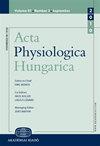Menstrual cycle phase effects free testosterone responses to prolonged aerobic exercise.
引用次数: 9
Abstract
Research has shown that total testosterone (tT) levels in women increase acutely during a prolonged bout of aerobic exercise. Few studies, however, have considered the impact of the menstrual cycle phase on this response or have looked at the biologically active free testosterone (fT) form responses. Therefore, this study examined the fT concentration response independently and as a percentage (fT%) of tT to prolonged aerobic exercise during phases of the menstrual cycle with low estrogen-progesterone (L-EP; i.e., follicular phase) and high estrogen-progesterone (H-EP; i.e., luteal phase). Ten healthy, recreationally trained, eumennorrheic women (X ± SD: age = 20 ± 2 y, mass = 58.7 ± 8.3 kg, body fat = 22.3 ± 4.9 %, VO(2max) = 50.7 ± 9.0 ml/kg/min) participated in a laboratory based study and completed a 60-minute treadmill run during the L-EP and H-EP menstrual phases at ~70% of VO(2max). Blood was drawn prior to (PRE), immediately after (POST) and following 30 minutes of recovery (30POST) with each 60-minute run. During H-EP, there was a significant increase in fT concentrations from PRE to POST (p < 0.01) while in L-EP fT levels were unchanged; which resulted in fT being significantly higher at H-EP POST versus L-EP POST (p < 0.03). Area-under-the-curve (AUC) responses were calculated, for fT the total AUC was greater in H-EP than L-EP (p < 0.04). There was no significant interaction of fT% between phases and exercise sampling time. There was, however, a main effect for exercise where fT% POST was a greater proportion of tT than at PRE (p < 0.01). In summary, hormonal changes associated with the menstrual cycle impact fT response to a prolonged aerobic exercise bout; specifically, there being higher levels under H-EP conditions. This suggests more biologically active T is available during exercise in this phase. This response may be a function of the higher core temperatures found with H-EP causing greater sex hormone binding protein release of T, or could be a function of greater degrees of glandular production. Further work is warranted to elucidate the mechanism of this occurrence. It is recommended that researchers examining T responses to exercise in women look at both tT and fT forms in order to have an accurate endocrine assessment in women.月经周期阶段影响游离睾酮对长时间有氧运动的反应。
研究表明,在长时间的有氧运动中,女性的总睾酮(tT)水平会急剧上升。然而,很少有研究考虑到月经周期阶段对这种反应的影响,或者研究了生物活性游离睾酮(fT)形式的反应。因此,本研究在低雌激素-孕酮(L-EP)的月经周期阶段独立检测了fT浓度的反应,以及tT的百分比(fT%)。即卵泡期)和高雌激素-孕酮(H-EP;即黄体期)。10名健康、休闲训练、无尿流的女性(X±SD:年龄= 20±2岁,体重= 58.7±8.3 kg,体脂= 22.3±4.9%,VO(2max) = 50.7±9.0 ml/kg/min)参加了一项基于实验室的研究,并在L-EP和H-EP月经期以VO(2max)的约70%完成了60分钟的跑步机跑步。每跑60分钟,分别在(PRE)前、(POST)后和(30POST)恢复后30分钟抽血。在H-EP期间,从PRE到POST, fT浓度显著升高(p < 0.01),而L-EP期间fT水平不变;H-EP后fT显著高于L-EP后(p < 0.03)。计算曲线下面积(AUC)响应,对于fT, H-EP的总AUC大于L-EP (p < 0.04)。运动阶段与运动采样时间之间的fT%无显著交互作用。然而,运动的主要影响是fT% POST与tT的比例大于PRE (p < 0.01)。总之,与月经周期相关的激素变化会影响fT对长时间有氧运动的反应;具体来说,在H-EP条件下会有更高的水平。这表明在这一阶段的运动中可以获得更多的生物活性T。这种反应可能是H-EP较高的核心温度导致性激素结合蛋白释放更多的T,或者可能是腺体分泌程度更高的功能。需要进一步的工作来阐明这种发生的机制。研究人员在检查女性对运动的T反应时,建议同时观察T和fT的形式,以便对女性的内分泌进行准确评估。
本文章由计算机程序翻译,如有差异,请以英文原文为准。
求助全文
约1分钟内获得全文
求助全文

 求助内容:
求助内容: 应助结果提醒方式:
应助结果提醒方式:


